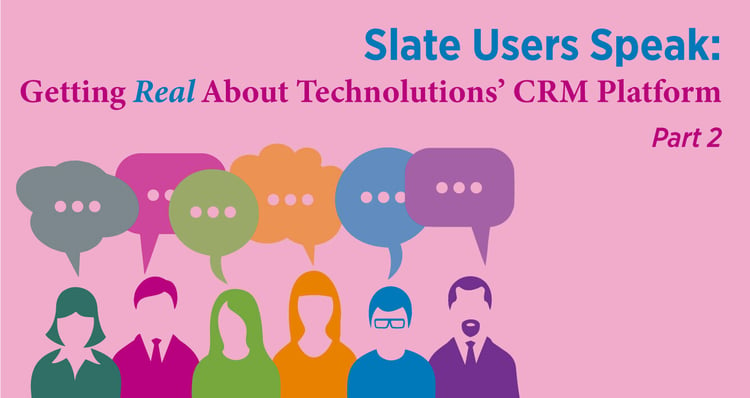
Welcome to Part 2 of our Slate series. You didn't think we'd forget about the international student recruitment/admissions perspective, did you?
But let's stay with domestic student recruiting and enrollment management for just a moment. Intead and iSchoolConnect are participating in a Chronicle of Higher Ed webinar event on Thurs, Feb. 4 that you truly won't want to miss. Colleagues from SUNY Fredonia, U of Richmond, and Robert Morris, along with some special guests all addressing the challenges of technology implementation on university campuses. Register Here.
Now, about that Slate CRM! In Part 1 last week we shared the experiences of a variety of Slate users in universities across the US, including admissions directors, associate directors, specialists, and one CRM manager/power user. We talked all things integration, training and support, and the universally dreaded: getting queries to give you the information you want.
This week we're talking all things international, as well as sharing our users' feedback on the cost and value of Slate to their institution.
In our work with institutions on international student recruitment campaigns, we're all too familiar with the domestic/international divide when it comes to resourcing and decision-making influence. And in our discussions with users about Slate integration, some international admissions staff reported a similar disconnect in their experiences with initial training and usage of the platform.
Again, we are grateful to our interviewees for sharing their valuable time and perspectives with us. Read on to learn how international recruiting/admissions teams are making Slate work for them.
The International Perspective
Our international admissions respondents reported varying experiences in their training and usage of Slate compared to their domestic counterparts.
In integration, several international users felt like an afterthought: “Nothing is ever what you think it’s going to be from an international perspective,” reported one international admissions director whose team received little institutional technical support in their Slate implementation following separate, more robust domestic and graduate student rollouts.
Based on our conversations with institutions, this was a common experience, with representatives from domestic admissions only serving as the Slate Launchpad attendees, receiving training, and distributing that knowledge to the broader admissions organization.
Additionally, some international application nuances, including reported English and unofficial test scores, global GPAs, and the myriad of international student databases (e.g. high school, non-high school, agent, and partner), still require manual management on the back end. Because what would international admissions be without a little (or a lot) of mental gymnastics?
Overall, for teams with strong internal technical support, adapting Slate to their nuanced international needs has been relatively smooth. “We’ve come light years. I can’t think of anything we haven’t been able to do yet,” reported one associate director of admissions.
Those institutions devoting less in the way of internal tech support or other resources found higher rates of frustration with the CRM. While our research for these posts gathered anecdotal evidence, we know from our work with a wide range of EdTech platforms that it is quite common for institutions to under resource an implementation and tech support and thereby reduce (or worse) the benefits of the technology investment.
Cost and Value
On the question of Slate’s hefty price tag, responses regarding its value were unanimous. “It has changed the way our office does business for good, and it’s something I would advocate for even if the cost was raised,” reported one user.
For another international recruitment and admission specialist, whose small public institution had chosen for many years to forego a CRM altogether, the budget invested in Slate represented a re-allocation of resources and strong efficiency improvements: “When you don’t pay for a CRM, you end up paying in human resources, retrofitting, programming, and the many people who put so much time into cobbling together the old system. If you were to translate that into dollars, it would have been more expensive to not have Slate, than to have it.”
The Bottom Line
Slate is a valuable tool with the power to transform your end-to-end admissions processes. As with any new technology, integration will likely be a headache no matter how you slice it. Investment in data-focused staff and training will save your whole team time and resources in the long haul as you brave the learning curve together.
If your institution has limited resources and cannot provide the strong internal technical support that can serve the needs of your entire admissions organization, at least ensure that your international teams are getting the support they need from their domestic counterparts through robust internal training materials (at minimum), and ideally through direct training for one international admissions representative.
To put a fine point on it: investing in training and tech support will motivate your team to wring the most value out of any technology investment you make. The alternative path, under resourcing, will foster the institution-killing apathy (or worse) that drives talent away and leaves goals unmet, i.e. an entirely undermining waste of money and time.
If you’re considering Slate or another CRM, our CRM Decision Guide (available via Intead Plus) is helpful as a planning tool as you move forward. Pro tip: it's all about the human side (user adoption).
And when it comes to CRM features and your team's consistent use of those features: Without the ability to segment and differentiate your messaging, your content is more likely to be deleted than read by your target audiences, i.e. marketing dollars spent with no valuable results.
A platform does not produce amazing, targeted content. It only gives you the capacity to employ that content effectively and measure the results. That’s where your (or our) talented team comes in. Get in touch to take your messaging segmentation and results analysis to the next level and maximize the value of your CRM and your marketing investment.


